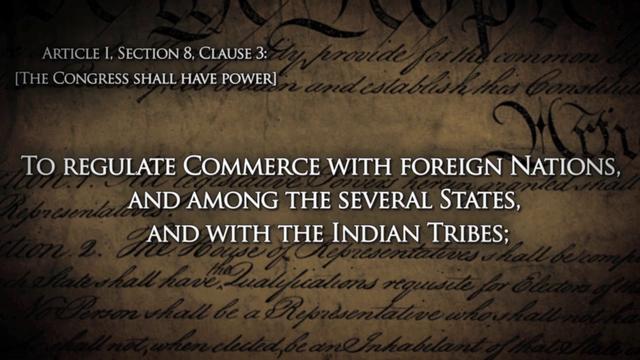This year the Supreme Court will hear consolidated cases involving the scope of Congress’s authority to “regulate Commerce . . . with the Indian Tribes”—the Indian Commerce Clause. One of the cases comes from the U.S. Court of Appeals for the Fifth Circuit, which held that the clause gives Congress almost unlimited power.
In 2007, I did a research study on the Indian Commerce Clause. Its conclusions were outlined in an article entitled, The Original Understanding of the Indian Commerce Clause, which was published the following year. I concluded that the Constitution created a different regime for addressing “Indian Affairs” than had existed under the Articles of Confederation. (“Indian affairs” was the Founding-Era term for all relations with the Indians.)
Under the Articles, the entire Indian affairs power was given to the Confederation’s single central branch—the Confederation Congress—subject to two broad exceptions in favor of the states. There were efforts during the Constitutional Convention to grant the new federal Congress wide “Indian affairs” authority as well. Instead, however, the Convention decided on a “separation of powers”’ approach:
* The new federal Congress received power to regulate “commerce” with the Indians, as with foreign nations and among the states. This gave Congress power over the Indian trade and certain activities traditionally connected with trade.
* Congress also received power over some Indians under the Territory and Property Clause and the Define and Punish Clause, and lesser authority under other provisions.
* Other Indian affairs powers were lodged in the President, in the case of armed conflict, and in the President-and-Senate, who could make treaties with individual tribes. Thus, if the federal government wished to exercise peacetime, non-commercial power over Indians outside federal lands, it had to do so through the treaty mechanism.
* To the extent not preempted by the foregoing, the states governed Indians within their borders.
Claims that the Indian Commerce Clause gives Congress unlimited and/or exclusive Indian affairs authority are wrong. Such claims are inconsistent with the Constitution’s separation of powers approach.
Justice Clarence Thomas has been kind enough to cite this article on several occasions. In the present Supreme Court case, some of those arguing for reversal of the court of appeals are citing it as well.
Enter Ablavsky
In 2015, a law professor named Gregory Ablavsky wrote an article arguing for a broader, “holistic” interpretation of the Indian Commerce Clause. He disagreed with my conclusions, but in a generally respectful way. In 2019, however, he filed a “friend of the court” brief with the court of appeals that included a slashing attack on my scholarship, my scholarly standards, and (at least inferentially) on my honesty.
Had I known about this brief, I would have responded immediately. Incredibly, however, no one informed me of it until March 23, 2022. It has been part of the public record for over three years, but as of this writing I have been aware of it for only two weeks.
When I finally got a chance to review it, I was stunned. Disagreement is part of the scholarly and legal process. But this was more than disagreement: The section of the brief directed at me had a “shyster” quality that rendered it out of place for a legal scholar and, indeed, for any brief submitted to a federal court.
The brief repeatedly misrepresented my positions—and on one occasion, the position of Justice Thomas. It threw unfair imputations on a careful, objective—and, I believe, accurate—examination of how the Constitution’s ratifiers understood the Indian Commerce Clause. It wrenched quotations out of context to make them appear to say things they did not. And it contradicted statements Ablavsky himself had made in his 2015 article.
I am currently involved in a larger Indian Commerce Clause project to be published later this year. A complete response will have to wait for that event. In the meantime, I offer the following as a partial one.
Ablavsky’s Methods
Four different approaches in Ablavsky’s brief lead me to say it has a shyster-like quality:
(1) It misrepresents my conclusions and then attacks the misrepresented version rather than what I actually wrote.
(2) It wrenches quotations out of context to make them appear to say things they did not.
(3) It seeks to divert attention away from how the ratifiers understood the Constitution during the ratification process and toward how federal congressmen and officials may have understood it after ratification. Of course, self-interested federal officials’ subsequent interpretation of their own powers is virtually worthless as evidence of the previous ratification bargain.
(4) It contradicts some of Ablavsky’s own statements in his 2015 article. (Examples of this appear in the wider discussion below.)
Misrepresenting Conclusions
A. Misrepresenting Justice Thomas and me on the Definition of “Commerce”
Ablavsky writes: “Natelson also argues . . . that [during the Founding era] commerce with the Indian tribes was limited solely to trade.” (Brief, p. 15)
That statement is highly misleading.
My article summarized several studies concluding that regulating commerce encompassed not merely regulating trade, but certain activities traditionally identified with trade. Here is the actual passage from the article:
Those studies have found that, in the legal and constitutional context, “commerce” meant mercantile trade, and that the phrase “to regulate Commerce” meant to administer the lex mercatoria (law merchant) governing purchase and sale of goods, navigation, marine insurance, commercial paper, money, and banking. (Original Understanding, p. 214).
Below, we’ll see how a particular kind of criminal statute was covered by this definition as part of the law merchant.
Ablavsky also misrepresents Justice Thomas along with me:
Justice Thomas’s Adoptive Couple concurrence argued that the Constitution narrowed rather than expanded federal power over Indian affairs. Adoptive Couple, 570 U.S. at 656. . . . Thomas’s interpretation . . . relied principally on a law review article written by former academic Robert Natelson that argued for a limited federal power over Indian affairs. (Brief, p. 13).
But Neither Justice Thomas nor I were addressing “federal power.” We were addressing congressional power under the Indian Commerce Clause. What Thomas actually said was:
Congress’ assertion of “plenary power” over Indian affairs is also inconsistent with the history of the Indian Commerce Clause. At the time of the founding, the Clause was understood to reserve to the States general police powers with respect to Indians who were citizens of the several States. The Clause instead conferred on Congress the much narrower power to regulate trade with Indian tribes—that is, Indians who had not been incorporated into the body-politic of any State.” (Italics added.)
Similarly, my article was about Congress’s power under the Indian Commerce Clause. I repeatedly stated that the federal government could address areas outside of “commerce” by, for example, using the treaty power.
It is worth noting that in his 2015 article, Ablavsky himself admitted that the Indian Commerce Clause was insufficient to support claims of “plenary” federal power over the Indian tribes—and that the other traditional props to federal power (such as the Treaty Power and the Territories and Property Clause) had become irrelevant. As he put it, “the props that once supported exclusive federal power have been knocked out, only a single slender pillar survives to support the edifice.” (p. 1051).
But he failed to mention that in his amicus brief.
2. Misrepresenting my comments on the word “nation” in the Indian context.
Here again is Ablavsky:
“Similarly, Natelson asserts—based on his “knowledge of Latin”—that the word “nation” was not associated with political sovereignty in the Founding era. . . . . But this claim, too, is contradicted by historical evidence. See, e.g., James Duane’s Views on Indian Negotiations (1784), in 18 Early American Documents, supra, at 299-300 (insisting, in negotiating with the Iroquois, that he ‘wou[l]d never suffer the word nations, or Six Nations . . .or any other Form which wou[l]d revive or seem to confirm their former Ideas of Independence.’)” (Brief, pp. 14-15)
Here’s what I actually wrote:
“Referring to tribes as ‘nations’ was consistent with exercising political jurisdiction over them because at the time the word “nation” did not necessarily evoke the association with political sovereignty it evokes today. The more common meaning of ‘nation’ followed its Latin root, natio, in referring merely to a people or ethnic group or the inhabitants of a general territory. In his famous Dictionary of 1756, Samuel Johnson defined ‘nation’ as, ‘[a] people distinguished from another people.’ Similarly, Nicholas Bailey’s 1783 Dictionary defined ‘nation’ as ‘[t]he people of any particular country’ and only secondarily as ‘the country itself.’ Hence, a North Carolina legislator might simultaneously think of the Cherokees as a “nation” yet vote to apply North Carolina law to Cherokees living within state borders.
“To be sure, the contemporaneous definition of ‘nation’ did not exclude the possibility that some tribes were thought of as sovereign. A member of the founding generation might well think of some tribes as sovereign entities. But one cannot generalize from the use of the word ‘nation’ to a conclusion that the Founders thought all tribes were sovereign.” (Original Understanding, p. 259).
As you can see, Ablavsky claimed I was relying on a knowledge of Latin, when in fact I was relying 18th century English dictionaries. And he said I denied that “nation” could be connected to sovereignty, when I actually said was the word “nation” did not exclude the possibility that some tribes were thought of as sovereign. The example Ablavsky gives—the Iroquois—had more claim to “nationhood” in the modern sense than did some other tribes.
Again, his amicus brief contradicts his 2015 article. In the article, he admitted that, despite the common habit in the 18th century of referring to Indian “nations,” European-Americans did not necessarily think of all these “nations” as sovereign. “The frequent assertion that early Americans,” he wrote, “regarded Indian tribes as separate sovereigns outside U.S. jurisdiction is too simplistic.” He went on to point out that some tribes were subject to state law and taxation (pp. 1054-55). He attributed the regular attribution of “sovereignty” to Indian tribes to the Washington administration, essentially as a policy maneuver (p. 1061 ff), and asserts that Secretary of State Thomas Jefferson’s attribution of full sovereignty to Indians was “disingenuous” (p. 1063; see also 1064-65).
3. Misrepresenting My Comments on the Indian Intercourse Act of 1790
Yet another misrepresentation pertains to the Indian Intercourse Act, a law Congress passed in 1790 to regulate trade with the Indians and to carry out the obligations imposed by the three “Hopewell” treaties. The law included a provision imposing criminal penalties on certain non-Indians. Some commentators have argued that the imposition of criminal penalties suggests that Congress may regulate almost all interpersonal relations as “commerce.”
My article first discussed evidence showing why this particular criminal measure was one traditionally associated with trade and therefore fell within the definition of “regulating commerce.” Then I added this explanation for why the law more likely was adopted to carry out the Hopewell treaties:
“In 1785 and 1786 Congress entered into the three “Hopewell” treaties with the Cherokees, Chickasaws, and Choctaws. By the terms of all these treaties, the United States had promised to regulate trade between the United States and the Natives “[f]or the benefit and comfort of the Indians, and for the prevention of injuries or oppressions on the part of the citizens or Indians.” The tribes, President Washington, and Secretary of War Henry Knox all were unhappy over white abuses that continued in defiance of the treaties, and became convinced that enforcement legislation was needed.
“On August 22, 1789, the President entered the chamber of the Senate and consulted its members on Indian affairs. After reciting the tribes’ dissatisfaction, he noted that the Cherokees lived primarily in North Carolina, which had not yet joined the union, and added:
‘The commissioners for negotiating with the Southern Indians may be instructed to transmit a message to the Cherokees, stating to them, as far as may be proper, the difficulties arising from the local claims of North Carolina, and to assure them that the United States are not unmindful of the treaty at Hopewell . . . .. . . .
‘The Commissioners may be instructed to transmit messages to the said tribes, containing our assurances of the continuance of the friendship of the United States, and that measures will soon by taken for extending a trade to them agreeably to the treaties of Hopewell.’
“The President then proceeded to impress upon his listeners the importance of an early agreement with the Creeks. He returned two days later for further consultation. Congress responded the following summer by enacting the Indian Intercourse Act. Hence, the first three sections of the Act were designed to fulfill the promise of the United States to regulate trade for the benefit of the Indians. Section 4 was, by its terms, designed to effectuate Indian treaties.
“Section 5—the substantive criminal provision—loosely tracked the language in another provision of the Hopewell pacts, which required that United States citizens who committed crimes in Indian country be tried and punished as if they had committed those crimes against fellow citizens. Provisions in treaties that defined and provided for punishment of crimes were well precedented.
* * * *
“A law enacted to execute the Treaty Power cannot be said to represent an interpretation of the Commerce Clause. (pp. 254-256).”
Yet here’s how Ablavsky characterized this lengthy discussion: “Natelson argues . . . that the Trade and Intercourse Act was enacted solely pursuant to Congress’s Treaty Power, citing apparent similarities with contemporaneous Indian treaties . . . .” (Brief, p. 14) That’s it!
He concealed the fact that my conclusion relied on the chronology of events and on statements by President George Washington.
Ripping Quotations Out of Context
Ablavsky cites the Annals of Congress from 1792 to demonstrate the wide reach of the Indian Commerce Clause. Here is his language:
“Yet when some in Congress proposed removing the [Indian Intercourse Act’s] criminal provisions as duplicative of treaty provisions, the proposal failed: ‘[T]he power of Congress to legislate, independent of treaties, it was also said, must be admitted; for it is impossible that every case should be provided for by those treaties.’” 3 Annals of Cong. 751. (Brief, p. 14)
Now, you might think that, reading this passage in isolation, that Congress was adopting a criminal law measure under the Indian Commerce Clause. But shortly before the passage he quotes, the following appears:
“In opposition to this motion, it was said that the power of the General Government to legislate in all the territory belonging to the Union, not within the limits of any particular State, cannot be doubted. “(Id.)
In other words, the measure’s defenders were saying this was legislation under the Territory and Property Clause, not under the Indian Commerce Clause. That’s why such legislation was good only “not within the limits of any particular State.”
Here’s another example of taking quotations out of context:
My article mentions an anonymous essay written in June, 1788 by an anti-federalist—an opponent of the Constitution. Ablavsky says that I erred in attributing it to Robert Yates rather than to Abraham Yates.
What he doesn’t tell you is that whether Abraham or Robert Yates wrote this passage is a matter of dispute. I followed Herbert J. Storing’s Complete Anti-Federalist, which states that it was Robert. Ablavsky follows the accompanying editorial comment in Volume 20 in The Documentary History of the Ratification of the Constitution, which claims it was Abraham. Of course, it is misleading to impugn my scholarship because I followed one standard source rather than another.
The fact is that when I wrote this article, Volume 20 of the Documentary History was new, our law school library was among the smallest in the nation, and I did not yet have access to that volume. Otherwise, I would have noted the disagreement.
At any rate, whether the anonymous writer was Robert or Abraham Yates is not germane to my thesis.
What is more serious is that Ablavsky continues in this vein:
“Perhaps most glaringly, Natelson relies on an inaccurate transcription of Anti-Federalist Abraham Yates, Jr.’s objection to federal power over Indian affairs. The source that Natelson cites entirely omitted the language, quoted above, that ratification would ‘totally surrender into the hands of Congress the management and regulation of the Indian affairs.’” (Brief, p. 13)
There are two problems with this attack. First, as he passingly admits, the additional language was not in the only standard source available to me. Second, the wider context of the passage suggests that Yates was not complaining about the power of the new federal Congress alone, but about the proposed new federal government.
Yates’ essay complains of alleged abuses by the Confederation Congress and then proceeds:
“If this was the conduct of [the Confederation] Congress and their officers, when possessed of powers which were declared by them to be insufficient for the purposes of government, what have we reasonably to expect will be their conduct when possessed of the powers “to regulate commerce with foreign nations, and among the several states, and with the Indian tribes,” when they are armed with legislative, executive and judicial powers, and their laws the supreme laws of the land—and when the states are prohibited, without the consent of Congress, to lay any “imposts or duties on imports or exports,” and if they do, they shall be for the use of the treasury of the United States—and all such laws subject to the revision and controul of Congress.
“It is therefore evident that this state, by adopting the new government, will enervate their legislative rights, and totally surrender into the hands of Congress the management and regulation of the Indian affairs, and expose the Indian trade to an improper government—and the traders to be fleeced by iniquitous impositions, operating at one of the same time as a monopoly and a poll tax . . . .”
20 Documentary History, at pp. 1158.
Note that the writer attributed the potential abuses not to the Indian Commerce Clause alone but to the whole potpourri of new federal powers, including Congress’s taxing power and the “executive and judicial powers.” And when he wrote of a “total[] surrender into the hands of Congress [of] the management and regulation of the Indian affairs,” that context—including the mention of the executive and judicial powers—suggests that he meant the entire central government, not the new federal Congress alone. Why would an author say “Congress” when he meant the entire central government? Because under the Articles of Confederation (which were still in effect when he wrote) Congress was the entire central government, and old habits are hard to break. (Many of us, for instances, when writing dates, still sometimes revert to “19–” instead of “20–“.)
Using Later Material to Divert from the Ratifiers’ Understanding
It is an error in historical method to use later events and understandings to draw conclusions about what a group (such as the Constitution’s ratifiers) thought years earlier. This is because the group had no knowledge of events or understandings that hadn’t happened yet. As I explain in my article, this error in historical method is called “anachronism.”
In the portion of his brief attacking my work, Ablavsky repeatedly commits this mistake. For example, he cites the 1790 Indian Intercourse Act, which was adopted over a year after the federal government had begun operations. The 1792 congressional statement that he (selectively) quotes was issued even later.
Another example is how he treats my extensive survey of the Founding-Era meaning of “commerce” and “commerce with the Indians.” My article examined British as well as American usages because American and British regulation of Indian affairs had been tightly bound together until a few years before the Constitution was written. Indeed, a review of British commercial statutes shows that they included virtually every kind of regulation of Indian commerce known to those who ratified the Constitution—debunking the common claim that Congress’s power to “regulate Commerce . . . with the Indian Tribes” was different or broader than its power to “regulate Commerce with Foreign Nations [and] among the several States.”
Ablavsky’s response is to replace material known to the ratifiers with sources arising after the ratification. (Brief, p. 15) But, again, events that occurred after the ratification was over cannot have been within the contemplation of the ratifiers at the time of ratification.
Conclusion
There will be more on these points in my publication later this year. That article will examine subsequent literature, new findings, and the specific issues now before the Supreme Court.








